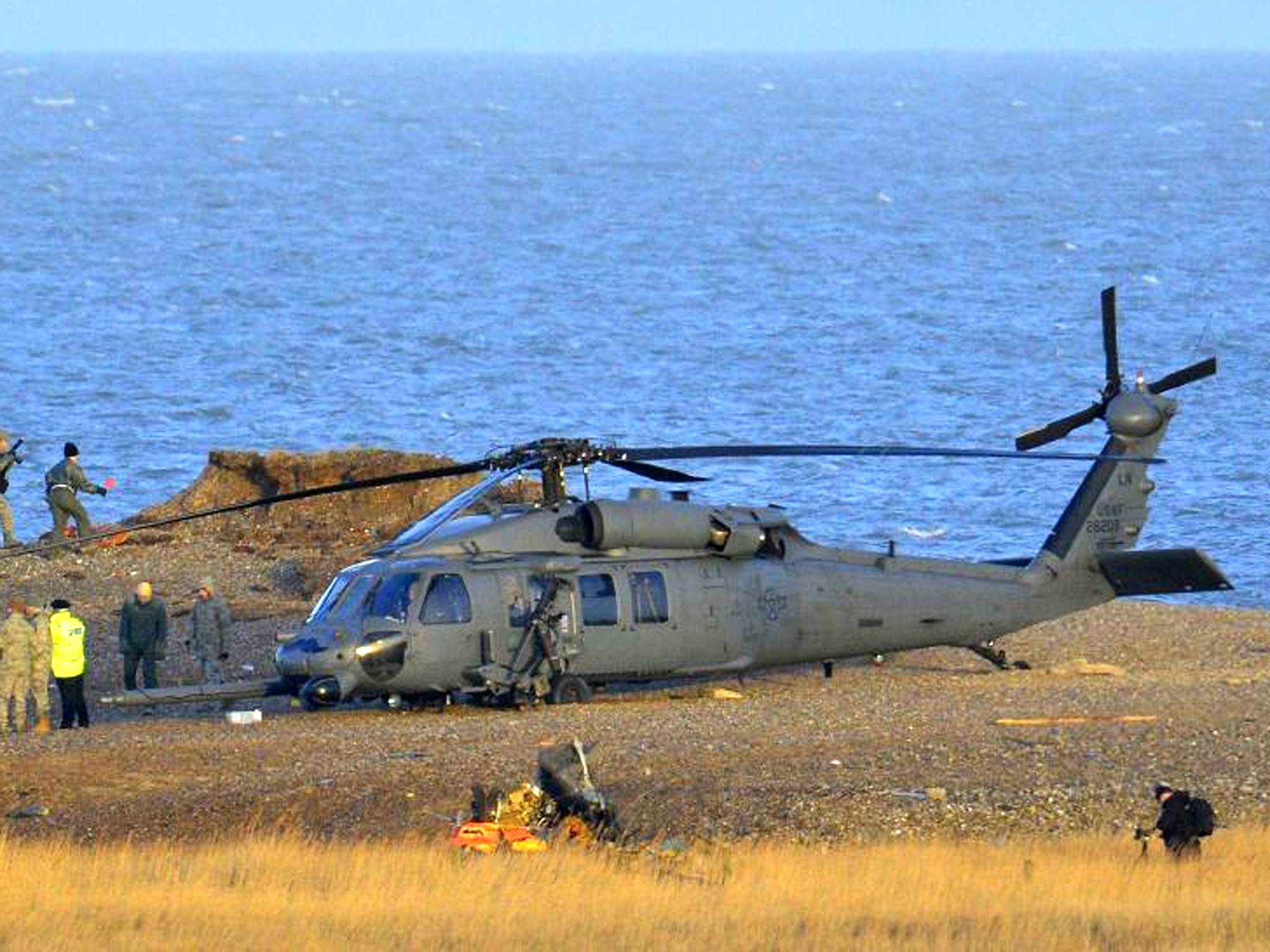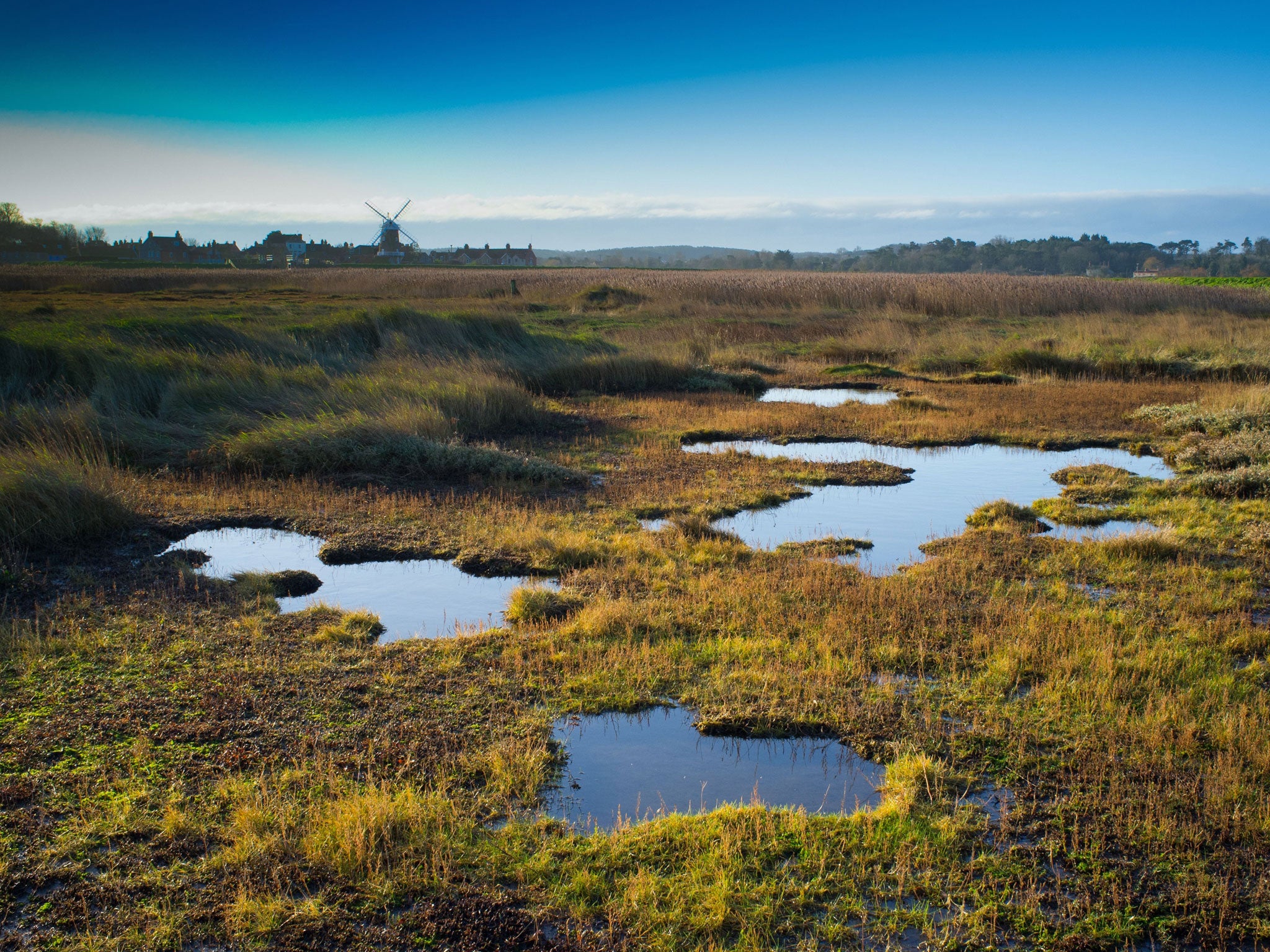Norfolk helicopter crash: Investigation launched into how 'safest ever' US aircraft came down in Cley marshland, killing four
The helicopter was one of two on a low-altitude training exercise when it plunged into flooded marshland yards from beach

Your support helps us to tell the story
From reproductive rights to climate change to Big Tech, The Independent is on the ground when the story is developing. Whether it's investigating the financials of Elon Musk's pro-Trump PAC or producing our latest documentary, 'The A Word', which shines a light on the American women fighting for reproductive rights, we know how important it is to parse out the facts from the messaging.
At such a critical moment in US history, we need reporters on the ground. Your donation allows us to keep sending journalists to speak to both sides of the story.
The Independent is trusted by Americans across the entire political spectrum. And unlike many other quality news outlets, we choose not to lock Americans out of our reporting and analysis with paywalls. We believe quality journalism should be available to everyone, paid for by those who can afford it.
Your support makes all the difference.An investigation is underway after four crew members were killed when a US military helicopter on a training mission crashed near the north Norfolk coast.
The HH-60 Pave Hawk, a derivative of the Sikorsky Black Hawk aircraft, plunged into marshland at Cley-next-the-Sea at about 6pm.
Emergency services worked throughout the night with the help of military personnel and volunteers to secure the crash site, with some debris threatened by tidal waters.
The US Air Force said the helicopter went down between a beach car park at Cley and Eastbank, near Salthouse - an area which remains flooded following the recent tidal surge.
An investigation has now been launched into how the aircraft, described as having "the best safety record of any helicopter that the US has ever owned", could have crashed during a routine low-level training exercise.
The Pave Hawk was stationed with the 48th Air Wing at the US Air Force base at RAF Lakenheath, Suffolk, which issued a statement saying: "US military officials are coordinating the recovery efforts with the UK police and the Ministry of Defence.
"The authorities have secured the crash site and established a cordon.
Police said all four crew members on board the helicopter at the time were killed in the crash, and that wreckage including live munitions had been scattered across an area the size of a football pitch.
Speaking near the scene, Chief Superintendent Bob Scully of Norfolk Police said it was too early to say what caused the crash.
He said the aircraft had contained ammunition, and that a 400 metre-wide area had been closed off because the scattering of bullets made the site "hazardous to members of the public".
A second helicopter from RAF Lakenheath was also in the area at the time of the crash and set down on the marshes to try to assist.
Mr Scully refused to speculate on whether the second helicopter had any involvement in the incident but said that, as it was nearby at the time, it made sense that it went to help.
He went on: "We are moving from a potential recovery operation to one of preserving the scene and carrying out an investigation."
Richard Kelham, the chairman of Cley Parish Council, told ITV News that the helicopter was thought to have landed in a bird reserve. North Norfolk is famous as a birdwatching area and is popular with walkers and tourists.
But speaking to BBC News, retired colonel and former Pave Hawk pilot Rick Davis said it was highly unlikely that a so-called bird-strike would have caused any problems for the aircraft.
He said one possible explanation, based on the presence of live ammunition on board the helicopter, could be that the crew got into difficulties while going through strenuous "battle-ready" preparations.
He added that the crash was particularly unusual given the fact that "the Pave Hawk may have the best safety record of any helicopter that the United States military has ever owned".
Peter and Sue McKnespiey, who run Cookies crab shop in Salthouse, live near the crash site and said they heard the helicopter come over "very fast and very low".
Mrs McKnespiey said: "I don't know about engines but I am used to the sound of helicopters and this sounded very heavy and very unusual. My gut instinct was there was something wrong."
Speaking to the Telegraph, Mr McKnespiey added: "They usually make a distinctive sound, but this one sounded like it was misfiring."
Nearby residents told the Eastern Daily Press newspaper that they later heard American F-15 fighter aircraft searching overhead. More helicopters were also circling the area.

Mr Scully said the US authorities had been responsible for notifying the next of kind of those who died. "As you would expect, we in the UK police have expressed our condolences to our US colleagues for the loss of some of their crew," he said. "It's a desperately sad time."
Norman Lamb, the Liberal Democrat MP for North Norfolk, said the crash was "utterly tragic", adding: "My heart goes out to the families of the crew, and it is all the more difficult because I suspect the families are from a long way away and the news is just filtering through. It is highly traumatic too for the local communities but it was quite close to the villages and could have been even more horrific if it came down on buildings."
The Ministry of Defence said the RAF was assisting police with the recovery operation.
The wartime role of Pave Hawks is to conduct rescue operations in hostile environments and recover isolated soldiers. They can also be used for civilian search-and-rescue missions, medical evacuations, disaster responses and humanitarian assistance. The $40.1 million (£24 million) Pave Hawk is 64ft long and can travel at speeds of up to 184mph (159 knots).
The US military deployed some of its Pave Hawk fleet to help in the aftermath of Hurricane Katrina in September 2005 and following the earthquake and tsunami in Japan in March 2011.
Today, Pave Hawks continue to support American military operations in Afghanistan, Iraq and Libya.
The crash comes weeks after a police helicopter crashed into the Clutha Pub in Glasgow on 30 November, killing 10 people.

Subscribe to Independent Premium to bookmark this article
Want to bookmark your favourite articles and stories to read or reference later? Start your Independent Premium subscription today.
Join our commenting forum
Join thought-provoking conversations, follow other Independent readers and see their replies
Comments